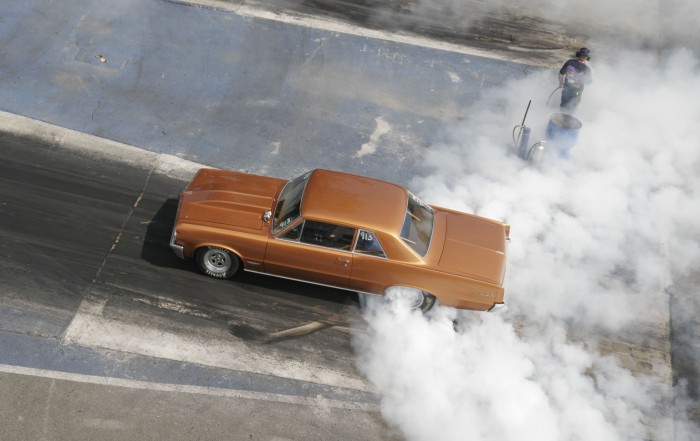EPA: Race cars have always required factory emissions equipment; SEMA: shenanigans
Posted on Feb 15, 2022 in Featured | 2 comments

In response to an outcry over the Environmental Protection Agency’s proposal to require intact factory emission control devices on race cars, the EPA maintained that has always been the rule, prompting the automotive aftermarket to call foul and take action to block the proposal.
Included in a 629-page EPA/NHTSA proposal to regulate CO2 emissions and fuel consumption in medium- and heavy-duty trucks is an amendment to a prior EPA ruling that states “Certified motor vehicles and motor vehicle engines and their emission control devices must remain in their certified configuration even if they are used solely for competition or if they become nonroad vehicles or engines.”
As interpreted by the Specialty Equipment Market Association in a press release earlier this week, that meant an overall prohibition of vehicles originally designed for on-road use being converted into race cars, an interpretation that SEMA claims will severely curtail the $36 billion automotive aftermarket parts industry.
“This proposed regulation represents overreaching by the agency, runs contrary to the law and defies decades of racing activity where EPA has acknowledged and allowed conversion of vehicles,” said SEMA President and CEO Chris Kersting in the SEMA press release. “Congress did not intend the original Clean Air Act to extend to vehicles modified for racing and has re-enforced that intent on more than one occasion.”
An EPA spokesperson, on the other hand, contended that the Clean Air Act never gave race car builders carte blanche in terms of modifying their vehicles and that the EPA doesn’t intend to bring an end to motorsports with its ruling.
“People may use EPA-certified motor vehicles for competition, but to protect public health from air pollution, the Clean Air Act has – since its inception – specifically prohibited tampering with or defeating the emission control systems on those vehicles,” EPA spokesperson Laura Allen said in a statement. “The proposed regulation that SEMA has commented on does not change this long-standing law, or approach.”
Instead, Allen said that the language in the proposed regulation clarifies the distinction that the EPA makes between “nonroad vehicles” – that is, dirt bikes, snowmobiles, and other vehicles that the Clean Air Act doesn’t prohibit modifications to – and “certified motor vehicles” – cars, trucks, and highway motorcycles that fall entirely under the Clean Air Act’s purview. As stipulated in the regulation, any illegal tampering with emissions control devices – by a parts manufacturer or by a consumer – could result in a $37,500 fine.

Allen noted that the EPA’s chief concern remains whether vehicles with modified emissions control systems are used on public roads – ignoring the “for off-road use only” warning labels on many aftermarket parts – and whether aftermarket manufacturers are selling such parts for use on public roads. “EPA uses its limited federal resources on cases that have a large impact on protecting public health,” Allen said in a follow-up email.
Regardless, SEMA has started a petition to get the White House to block the EPA’s proposal, claiming that the Clean Air Act “prohibits the EPA from regulating racecars.” As of this writing, the petition has more than 113,000 signatures.
The existing law that the EPA seeks to amend, 40 CFR Section 86.1854-12(a)(3), prohibits anybody from removing, disabling, or bypassing emissions equipment on a motor vehicle, including its owner. Nowhere in that section does it make an exemption for competition use.
Published in the Federal Register last July, the proposed regulation in question – Greenhouse Gas Emissions and Fuel Efficiency Standards for Medium- and Heavy-Duty Engines and Vehicles—Phase 2 – aims to “reduce greenhouse gas emissions and fuel consumption for new on-road heavy-duty vehicles” starting with the 2018 model year. It remained open to public comments through September and is slated for adoption this coming July.
Spokespeople for SEMA, which participated during the public comment period last year but didn’t make its announcement on the regulation until Monday, claimed that the EPA intended to back-door the policy.
“We feel the EPA failed on all counts,” SEMA’s vice president for government affairs, Steve McDonald, told Jalopnik. “They did not give the public adequate notice.”
An EPA spokesperson said that the agency included the language about competition vehicles in a regulation concerned with medium- and heavy-duty truck emissions “because of a concern that other changes proposed in the rule might create confusion regarding how the Clean Air Act’s prohibition against tampering applies for vehicles used in racing. In particular, we were concerned that readers might mistakenly believe that the Clean Air Act’s explicit exclusion of vehicles ‘used solely for competition’ from EPA’s nonroad regulations (which is noted tangentially in the GHG rule) also applies for certified motor vehicles. It does not. This is true for all motor vehicles and motor vehicle engines, including both light-duty and heavy-duty.”





.gif)


Clean air is disappearing rapidly as is clean water. SEMA may want to play up election year conflict between their members and the Government, but the reality is that we need to control all sources of air and water pollution as a matter of conscience.
I beg to differ. We have drastically improved the quality of our air and water, there are numerous indicators of this, but the EPA is reluctant to acknowledge this. The tendency of any government agency is to build it’s empire and secure it’s own interests first. You need to research the particulate count monitoring by separate agencies NOAA for one) to get a clear picture.